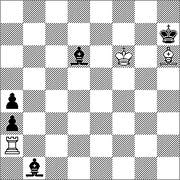Endgame study
|
|
An endgame study, or just study, is a composed chess position—that is, one that has been made up rather than one from an actual game—presented as a sort of puzzle, in which the aim of the solver is to find a way for White, moving first, to win or draw, as stipulated, against any moves that Black plays.
To the extent that they are composed positions and offer the solver a specific task, studies are similar to chess problems in which to stipulation is to "checkmate black in two moves against any defence", for example. However, while problems often present very artificial looking positions, studies often appear that they could occur in a game.
As with problems, for a study to be regarded as a good one, it must have only one solution. Some argue that White must only have only one move at each juncture to achieve one's aim, though some feel that minor alternatives (such as a choice of moving a knight b1-c3-b5 or b1-a3-b5; see algebraic notation for an explanation of this notation) are permissible.
Composed studies predate the modern form of chess. Shatranj studies exist in manuscripts from the 9th century, and the earliest treatises on modern chess by the likes of Lucena and Damiano (late 15th and early 16th century) also include studies. However, these studies often include superfluous pieces, added to make the position look more "game-like", but which take no part in the actual solution (something that is never done in the modern study). Various names were given to these positions (Damiano, for example, called them "subtelties"); the first book which called them "studies" appears to be Chess Studies, an 1851 publication by Josef Kling and Bernhard Horwitz, which is sometimes also regarded as the starting point for the modern endgame study. The form is considered to have been raised to an art in the late 19th century, with A. A. Troitzky and Henri Rinck particularly important in this respect.
Most composers, including Troitzky, Rinck and other famous figures such as Genrikh Kasparyan, are known primarily for their studies, being little known as players. However, some famous players have also composed endgame studies, with Emanuel Lasker, Richard Réti, and Jan Timman being perhaps the most notable ones.
Réti_endgame_study_1.Kg7.png
To the right is an example study by Réti, one of the most famous studies of all time (first published 1922 in Neueste Schachnachrichten and reproduced many times since). It is White to play and draw. At first sight, this seems an impossible task: if White tries to chase after Black's pawn he can never catch it (1. Kh7 h4 2.Kh6 h3 etc. is clearly hopeless.), while it is clear that Black will simply take White's pawn if he tries to promote it.
White can draw however, by taking advantage of the fact that the king can move in two directions at once: towards Black's pawn and towards White's own. The solution is 1.Kg7 h4 2.Kf6 Kb6 (if 2...h3 then 3.Ke7 and 4.Kd7 allows white to promote his pawn) 3.Ke5!. Now, if 3...Kxc6 then 4.Kf4 stops Black's pawn after all, while if 3...h3 4.Kd6 allows White to promote the pawn. Either way, the result is a draw.
Not all studies are as simple as the above Réti example; the study to the right is by Kasparyan (first published in Magyar Sakkélet, 1962). White is to play and draw. The main line of the solution is 1.Ra1 a2 2.Ke6 Ba3 3.Bf4 Bb2 4.Be5 a3 5.Kd5 Bg6 6.Bd4 Bf7+ 7.Ke4 Bc4 8.Rg1, but there are various alternatives for both sides. For example, White could try 1.Bf4 on one's first move, with the idea 1...Bxa2 2.Bxd6 and 3.Bxa3 is a draw, but Black can defeat this idea with 1...Bxf4 2.Rxa3 Bc2, which wins. To understand why one move works and another one does not requires quite advanced chess knowledge. Indeed, it will not be obvious to many players that the position at the end of the given line is a draw at all.
For what is sometimes reckoned to be the most famous study of all, see Saavedra position.
Further reading
- John Beasley and Timothy Whitworth, Endgame Magic (Batsford, 1996), an introduction to the subject
- A. J. Roycroft, Test Tube Chess (Faber, 1972), a general overview of studies, including 433 examplesfr:Étude d'échecs

